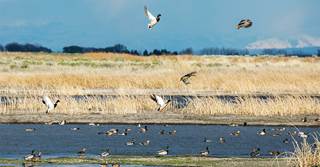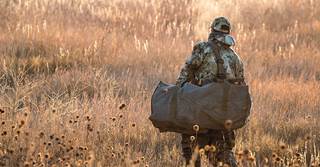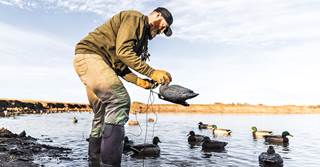Dealing with Drought
Here’s how to put together a successful hunt when Mother Nature leaves you high and dry
Here’s how to put together a successful hunt when Mother Nature leaves you high and dry

By Brian Haines
The three of us sat quietly in the bulrushes, watching intently as mallards circled overhead. They were early-season birds, in eclipse plumage and not yet unsettled by gunshots that rang out in the distance. I was just a kid, tagging along with my dad and grandfather, and I watched in awe as the ducks dipped their wings and glided over our heads. It was a magnificent initiation into the world of waterfowl hunting, and it came on a very warm and very dry opening day.
It was 1988, the year of the infamous drought that scorched its way across the Prairie Pothole Region of North America. During that year of intense heat and dry weather, 11 of the lower 48 states declared disaster areas in all of their counties. Wildfires raged in Yellowstone National Park. Wetlands dried up across the prairies, leaving little habitat for breeding waterfowl. Duck populations plummeted.
As bad as the drought was, though, it didnt stop ardent waterfowlers from heading out on opening day. For the three of us hunkered down in the bulrushes, and for many other waterfowlers across North America, it meant finding creative ways to adapt to a challenging season.
The arid conditions had reduced our slough to little more than a puddle surrounded by dry, cracked earth. But by hunkering down in a finger of bulrushes extending out into the slough, we were able to set up within shotgun range of the water, which the ducks wanted desperately. The deep, treacherous mud nearly sucked our boots off, but we were rewarded with plenty of shooting while many traditional hunting spots in the area were devoid of ducks.
Most veteran waterfowlers will tell you that drought doesnt necessarily spell disaster. In fact, with the right tactics, some creativity, and a little luck, you can still have some memorable huntsjust like my father, grandfather, and I did back in the 80s. Many areas of the continent experienced drought conditions during the past two seasons, and this year, especially in the West, hunters are likely to see those conditions again. So how do you find success when its warm and dry? We asked experienced hunters and professional guides for their advice on how to deal with drought on todays waterfowling landscape.

Photo Ken Archer
For ducks and geese, prolonged dry periods reduce the supply of suitable habitat. Waterfowl are forced to concentrate in what wetlands are available, and safe havens become harder to find. Rick Talkington is a longtime guide and the owner of Lone Star Fowl Boys Guide Service in Corsicana, Texas. On the dusty southern High Plains, drought comes with the territory. Scouting is key, Talkington says. Do your homework and find out where the birds want to be.
That can be a difficult task during a prolonged drought, and Talkington, like most hunters, spends a good deal of time scouting for locations where birds can find the habitat they need. Finding water is important, but in addition to water, ducks need food and places to get away from hunting pressure, he says. The best places usually offer all three of these elements.
In cases of extreme drought, many hunters look to reservoirs or other large bodies of water where drought-pressured birds concentrate. Zach Fahlberg of Duxmen Outfitters hunts in the vicinity of the famous Claypool Reservoir near Harrisburg, Arkansas, and he knows firsthand the attraction of large reservoirs in drought-stricken regions. When everything else is dry, reservoirs that are used for gravity-fed irrigation are good places to find ducks, he says. A reservoir of just about any size can provide a sanctuary for waterfowl. The problem is that many reservoirs cant be hunted, so you have to scout for nearby areas where you can hunt.
On many public properties across the United States, crop fields and other lands are artificially flooded to provide waterfowl habitat and hunting opportunities. A well-managed public area with the capacity to pump water can offer some phenomenal hunting during a drought, says Luke Naylor, waterfowl program coordinator for the Arkansas Game and Fish Commission. In Arkansas, we try to stagger pumping to help sustain habitat for the long term, so you sometimes have to put in some effort to find ducks, but these areas can still be really good.
Pumped public areas offer great hunting opportunities, but pumped private land offers some additional advantages. Duck season is only 60 days, so a day without water is a day wasted, Fahlberg says. Hunting private land thats been pumped is different than hunting public lands. The ducks are usually less pressured and theres more opportunity to see and hunt waterfowl. An 80-acre field takes about four days to pump. Ideally you want 12 to 24 inches of water on the land for about a week before you hunt it to let the ducks know that water is there.

Photo Blake Fisher\RNTCALLS.COM
Drought on the breeding grounds adds to the challenges waterfowlers can face. When high-quality wetland habitats are not available in traditional breeding and nesting areas, reproduction suffersa short-term effect that can linger for two or three years after drought conditions abate. We didnt add many ducks to our population in 2021, says DU Waterfowl Scientist Dr. Mike Brasher. If spring conditions are dry, some ducks simply wont breed, and those that do will be less successful. Thats what we saw last year.
In years with poor production, the fall flight consists largely of wary adult birds that are familiar with decoys, blinds, and calling. In 15 years of professional guiding, Ive found that drought-pressured birds require different tactics, says Graham Greseth, owner and head guide for Maxxed Out Guide Service in western Minnesota. Often it means using fewer decoys and less motorized equipment like spinning-wing decoys, or it might mean using no spinners at all.
Mike Peters, a veteran waterfowl guide who works with Greseth, suggests limiting your calling in these kinds of situations. When youre hunting pressured adult birds, lay off the call. Less is more, he says. Call just enough to keep them interested, but you have to know when to put the call down.
Talkington also stresses the importance of tailoring your hunting strategies in response to duck behavior. Every water hole is different, he says. Sometimes Ill set out fewer decoys and call less. Then again, at other times, Ill put out more decoys and call extra hard to let them know Im there. It really depends on the number of ducks and how they respond to what you are doing. The best advice is to stay versatile and tailor your strategy.

Photo Ed Wall Media
One major challenge during a drought year is how to adapt to conditions when hunting pressure is focused on areas with available water. Dry conditions can make virtually any open water prime real estate. When this happens, hunters are forced to concentrate in these areas. Hunters who can find ways to deal with hunting pressure are more likely to find success.
The 202122 season was dry in areas of western Minnesota, South Dakota, and Kansas, where we guide waterfowlers, Greseth says. We still had ducks, but they were concentrated in roost areas where there was suitable habitat. That may sound ideal at first, because it makes scouting easy. You know exactly where to find the birds and where theyre going every day. The problem is that everyone else knows where the birds are as well. When ducks get pressured, theyll stay on the roost all day and not leave to feed until after sundown. It can make them nearly impossible to hunt.
Consequently, for many hunters, the secret to success is finding hidden spots that are inaccessible or unknown to other hunters. Greseth looks for isolated spots that others may overlook. There are areas off the beaten path, he says. As a guide service, we have four to five vehicles on the road every night scouting to find those honey holes, but a close look at Google Earth is another great way to find water in secluded areas that might hold ducks. Another approach Greseth uses is to talk to farmers. Farmers always know whats happening on the land, he says, and youd be surprised at the information you can get by simply asking. Oftentimes, a smile and a handshake can get you a lot of valuable information.
Oxbow lakes can often be good targets for waterfowlers during dry times. (Oxbows are former bends in a river that have been cut off from the main channel). An oxbow can be a lifeline for hunters during a drought because the larger ones can hold thousands of birds, Fahlberg says. Unfortunately, the well-known oxbows on public land can have a lot of hunting pressure.
Naylor suggests looking for smaller, less pressured oxbows that might be difficult to access. When oxbows get disconnected from the main river, you often have to hike to them, Naylor says. A general strategy is to scout using satellite imagery and then get out of the boat and start walking. If you find a good spot, keep quiet about it and dont let it get too pressured, or the birds wont stick around.
Talkington is a firm believer in carefully managing hunting pressure in spots that are holding birds. After finding a good location, our strategy is to set up, hunt, and get out. When water is scarce, you want birds to return to that same spot, so its important not to linger after a hunt, he advises. If other hunters discover Greseths hidden spots, he looks for opportunities elsewhere. Sometimes, when pressure is high, your best bet is to watch the weather closely and wait until a cold front forces ducks to feed more actively, he says.
Another drought strategy is to target waterfowl feeding in dry fields. Greseth looks for fields close to roosts but urges caution when hunting in these areas. Drought-pressured birds usually feed in fields close to their roosts, he says. They dont want to move far from where they feel safe, so watch the wind when you hunt these spots. If possible, hunt a field that is downwind of the roost to avoid the sound of gunshots traveling into the roost and spooking already skittish birds.
Maintaining a flexible mindset might be the best advice for waterfowlers dealing with drought. Jim Martinosky, a veteran waterfowler and the owner and operator of Central Nebraska Outfitters for more than two decades, says that hunters cant fight Mother Nature but they can adapt. When dry weather or high temperatures disrupt or delay the flight south, there isnt really anything that we as hunters can do about it, he says. If the weather is warm, the birds dont move. In these situations, scouting becomes the key. If habitat is scarce, the birds that are around arent going to move far, if at all, especially if they have no place to go.
The 2021 drought affected us in a big way, Martinosky continues, but we adapted and still had some great hunts. With warm weather up north, we didnt have many big Canada geese heading our way, so we concentrated on lesser Canadas and other species. Birds that did come down had seen plenty of decoy spreads, so we changed things up by using more silhouette and windsock decoys for added movement in the spread. In a drought, its important to give pressured birds something different to look at.
When habitat is scarce and birds are skittish, scouting, adapting, and getting creative are the keys to finding success. This might mean switching up your gear, changing strategies, or maybe concentrating on jump-shooting or moving to big water. Get out there and give it a try. Just remember to stay flexible and keep an open mind and a positive attitude. And remember that droughts dont last forever.
Ducks Unlimited uses cookies to enhance your browsing experience, optimize site functionality, analyze traffic, and deliver personalized advertising through third parties. By continuing to use this site, you agree to our use of cookies. View Privacy Policy